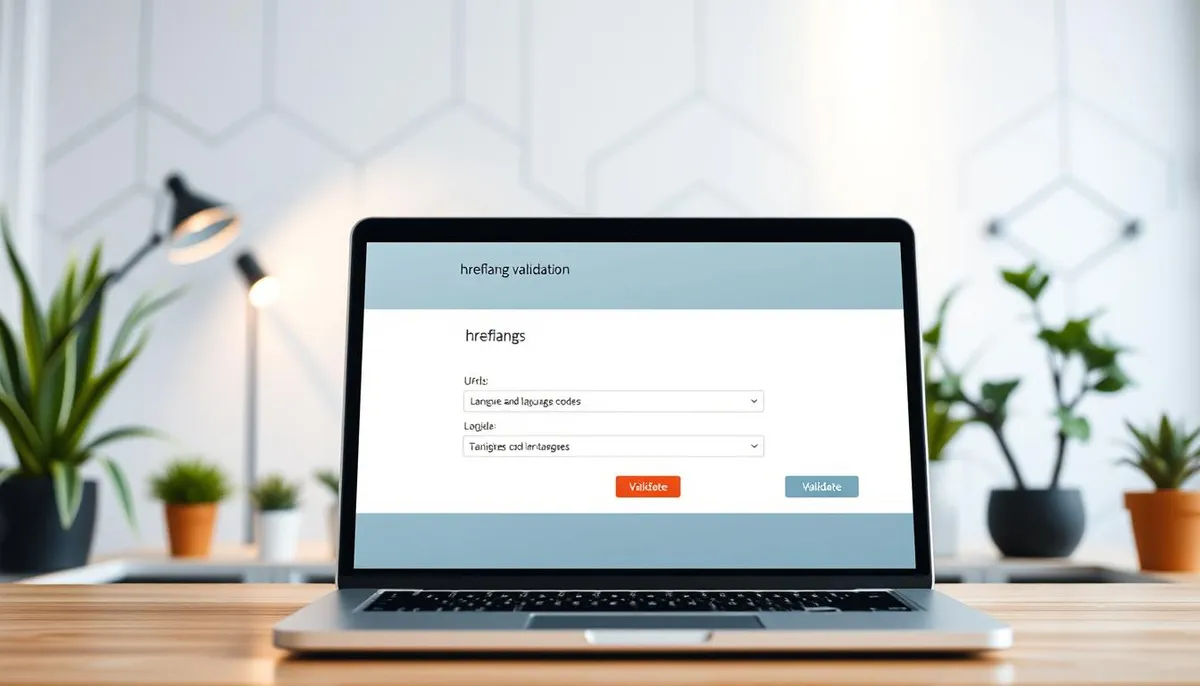In the realm of global web presence, a hreflang validator is your secret weapon. This tool ensures your website communicates effectively with the right audience. It acts as a language cop, ensuring every page speaks the visitor’s native language.

Why invest in a multilingual website validator? It keeps Google and your international visitors content. Proper hreflang setup tells search engines which language version to display in search results for specific regions.
UnlimitedVisitors.io, a leading SEO platform, understands the importance of hreflang implementation. It’s a key component in crafting an effective international SEO strategy. By employing a hreflang validator, you pave the way for global digital success.
Understanding Hreflang Implementation Basics
Hreflang tags are vital in international SEO. They guide search engines to show the right content to users, based on their language and location. Let’s explore the basics of hreflang implementation and its importance for global websites.
What Are Hreflang Tags?
Hreflang tags are HTML attributes that inform search engines which language and regional version of a page to display. They are critical for websites targeting multiple languages or countries.
Why Hreflang Tags Matter for International SEO
Effective hreflang implementation is key for international SEO success. It prevents duplicate content issues and ensures users see the most relevant site version. A language targeting validator can confirm your tags are correctly set up.
Core Components of Proper Hreflang Setup
To effectively set up hreflang tags, understanding their core components is essential:
- Language codes (e.g., ‘en’ for English)
- Country codes (e.g., ‘US’ for United States)
- The x-default tag for fallback content
| Component | Example | Purpose |
|---|---|---|
| Language Code | en | Specifies the language of the content |
| Country Code | US | Indicates the target country |
| x-default | hreflang=”x-default” | Serves as a fallback for unmatched languages/regions |
An hreflang tag checker can ensure your implementation is correct and effective for your international SEO strategy.
Hreflang Validator: Essential Features and Functions
Hreflang validators are vital for international SEO. They verify if your website’s language tags are correctly set up. They identify common errors and ensure your site functions well for users globally.
A reliable hreflang syntax validator performs several critical tasks. It checks if your language codes are accurate. It verifies that all pages link back to each other correctly. The tool also examines return tags, which are essential for Google to grasp your site’s structure.
Utilizing a validator saves time and minimizes errors. It’s extremely beneficial for large websites with numerous language versions. The tool can swiftly scan hundreds of pages, highlighting any issues. This facilitates prompt corrections, preventing negative impacts on your search rankings.
| Feature | Function |
|---|---|
| Language Code Check | Ensures correct language and country codes are used |
| Bidirectional Linking | Verifies all pages link back to each other correctly |
| Return Tag Validation | Checks for the presence of necessary return tags |
| Bulk URL Testing | Allows testing multiple URLs at once for efficiency |
Regular use of an hreflang validator keeps your international SEO efforts on track. It aids in identifying and resolving issues promptly. This ensures your site performs optimally across various languages and regions.
Common Hreflang Implementation Errors
Getting hreflang tags right is key for international SEO success. Many site owners struggle with these tags, leading to errors that harm their SEO across languages. Let’s look at common mistakes and how to steer clear of them.
Missing Return Tags Issue
One common blunder is neglecting return tags. This occurs when a page links to another language version but that page doesn’t link back. An international SEO tool can spot this by checking for reciprocal links among all language pages.
Invalid Language Codes
Another frequent error is using wrong language codes. For instance, some use dashes instead of hyphens or non-standard codes. A cross-language SEO analyzer can check if your codes follow ISO standards.
Incorrect URL Formatting
Wrong URL formatting can cause crawling problems. Make sure all URLs in your hreflang tags are absolute and match your page’s URL structure exactly. This means using the right protocol (http or https) and including any subdirectories.
Duplicate Content Problems
Hreflang tags are vital for handling duplicate content across language versions. Wrong use can confuse search engines, possibly causing SEO penalties.
| Error Type | Impact | Solution |
|---|---|---|
| Missing Return Tags | Incomplete language associations | Ensure all pages reference each other |
| Invalid Language Codes | Misinterpretation by search engines | Use ISO 639-1 format (e.g., en-US) |
| Incorrect URL Formatting | Crawling and indexing issues | Use absolute URLs with correct protocols |
| Duplicate Content | Potential SEO penalties | Properly implement hreflang for each version |
Proper URL Structure for International Websites
Creating an effective URL structure is essential for international websites. A well-designed URL structure helps search engines and users understand your site’s organization. It also enhances your multi-regional website checker results. Let’s explore key considerations for structuring URLs on global sites.
Trailing Slash Considerations
Search engines treat URLs with and without trailing slashes as separate entities. This can cause duplicate content issues. It’s important to choose one format and use it consistently across your site. A multi-regional website checker can help identify any inconsistencies in slash usage.
Domain Structure Options
When expanding globally, you have several domain structure choices:
- Country-code Top-Level Domains (ccTLDs): e.g., example.fr for France
- Subdomains: fr.example.com
- Subdirectories: example.com/fr/
Each option has its pros and cons. ccTLDs offer strong geo-targeting but require more resources. Subdomains and subdirectories are easier to manage but may need additional geo-targeting signals.
Country-Specific TLDs
Using country-specific TLDs can boost local credibility and improve geo-targeting. They require separate domain registrations and hosting. An hreflang implementation tester can ensure proper setup across your international domains.
Remember, the best URL structure depends on your business goals and resources. Regular testing with a multi-regional website checker and hreflang implementation tester will help maintain an effective international SEO strategy.
Advanced Hreflang Testing Capabilities
Hreflang validators have evolved significantly, now providing advanced features for multilingual SEO testing. These tools can manage large-scale websites with numerous language versions and complex structures. Let’s dive into the sophisticated capabilities that enhance hreflang validation, making it more thorough and efficient.
Today’s hreflang validators can thoroughly check implementation across various locations. They examine HTML head sections, HTTP headers, and XML sitemaps to verify consistent hreflang tag usage. This is essential for websites that deliver content in different ways.
Another significant feature is the ability to test with different user agents. This ensures hreflang tags function consistently across various search engine bots. By simulating different crawlers, validators offer a precise view of how search engines perceive your international SEO setup.
Advanced hreflang testing also includes:
- Bulk URL testing for large-scale websites
- Cross-referencing between language versions
- Identifying conflicting hreflang signals
- Generating detailed reports for easy analysis
These features enable webmasters to deeply understand their website’s international SEO health. By utilizing these advanced tools, you can ensure your hreflang implementation is strong and effective across your entire web presence.
Integration with Other SEO Elements
Effective use of hreflang tags requires seamless integration with other SEO elements. A good international SEO tool helps manage this complex interplay. Let’s explore how hreflang tags work alongside canonical tags, redirects, and XML sitemaps.
Canonical Tags and Hreflang
Canonical tags and hreflang tags serve different purposes but can coexist. Canonical tags indicate the preferred version of a page, while hreflang tags specify language and regional targeting. A hreflang tag checker ensures these tags work together without conflicts, maintaining your site’s SEO integrity.
Redirect Management
Proper redirect management is key when using hreflang tags. Redirects can impact how search engines interpret your international content. Using an international SEO tool, you can manage redirects effectively, ensuring they align with your hreflang implementation and don’t disrupt user experience.
XML Sitemap Implementation
Incorporating hreflang tags in your XML sitemap can boost your international SEO efforts. This approach helps search engines understand your site’s language and regional variations more quickly. A hreflang tag checker can verify correct implementation in your sitemap, improving crawling and indexing of your global content.

By integrating hreflang tags with these key SEO elements, you create a robust foundation for your international SEO strategy. Remember to use reliable tools to ensure proper implementation and avoid common pitfalls.
Automated Analysis and Reporting Tools
Modern hreflang markup tools bring powerful automated features to the table, making international SEO easier. They save you time and increase efficiency, which is vital for managing multilingual websites.
Excel Export Features
Language targeting validators often include Excel export options. This lets you download detailed reports on your hreflang implementation. Sharing these reports with team members or clients becomes seamless, improving collaboration.
Bulk URL Testing
Bulk URL testing is a significant advancement for large websites. It allows you to validate hundreds or thousands of pages simultaneously. This feature greatly reduces the time needed for hreflang audits on extensive multilingual sites.
Error Detection Systems
Advanced hreflang markup tools feature built-in error detection systems. These systems automatically scan your implementation, identifying issues like missing return tags, invalid language codes, or incorrect URL formats. Some tools even send real-time alerts, notifying you of problems immediately.
Utilizing these automated analysis and reporting tools helps maintain a strong hreflang setup with minimal manual effort. This lets you concentrate on other key aspects of your international SEO strategy. It ensures your language targeting remains accurate and effective.
Best Practices for Multi-Regional SEO
Effective multi-regional SEO demands meticulous planning and execution. Utilizing a multi-regional website checker is essential for identifying areas needing improvement. Begin by consistently implementing hreflang tags across your site. These tags inform search engines about the language and country targeted on each page.
Steer clear of automatic redirects based on IP addresses. Such redirects can alienate users and undermine your SEO efforts. Instead, provide clear language options for visitors to select. A cross-language SEO analyzer is invaluable for detecting issues with your language targeting.
Proper content localization is critical. Translating content verbatim is insufficient. It must be adapted to align with local culture, customs, and preferences. This includes adjusting images, colors, and examples to engage your target audience effectively.
International website structure management is also vital. Consider using country-specific domains or subdirectories to differentiate content for various regions. Ensure your hreflang implementations are current as your website evolves. Regular assessments with a multi-regional website checker are necessary to uphold a robust international SEO strategy.
Troubleshooting and Error Resolution
Implementing hreflang tags can sometimes lead to problems. A hreflang syntax validator is essential for spotting and correcting these issues. Let’s dive into some common troubleshooting steps to keep your international SEO efforts on track.
Language Code Validation
Accurate language codes are vital for hreflang tags. A hreflang implementation tester can confirm your codes adhere to ISO standards. For instance, ‘en-US’ is correct for American English, not just ‘en’. This ensures search engines accurately target your content’s audience.
Return Tag Verification
Missing return tags can perplex search engines. It’s important to verify that each page in your hreflang setup links back to all other language versions, including itself. This creates a complete circle of references, which is critical for proper implementation.
Implementation Debugging
Debugging hreflang issues requires examining various website components:
- HTML head: Ensure tags are correctly placed and formatted
- HTTP headers: Verify proper syntax for non-HTML files
- XML sitemaps: Confirm hreflang attributes are included for each URL

| Error Type | Resolution Steps |
|---|---|
| Invalid language codes | Use ISO 639-1 format for languages, add region codes if needed |
| Missing return tags | Add reciprocal hreflang links to all related pages |
| Incorrect URL format | Use absolute URLs, including protocol (http:// or https://) |
| Conflicting canonical tags | Ensure canonical and hreflang tags are consistent |
By tackling these common problems, you’ll enhance your website’s international SEO performance and user experience across various languages and regions.
Conclusion
Hreflang validators are essential for maintaining effective multilingual websites. They ensure your international SEO strategy is on track by identifying common errors and validating proper implementation. Regular use of a hreflang validator can save you time and boost your global search rankings.
Proper hreflang setup is key for reaching audiences across different languages and regions. Automated tools for ongoing hreflang management keep your multilingual website validator running smoothly. This approach helps you stay ahead in the fast-paced world of international SEO.
To maximize your global reach, consider integrating hreflang validation with broader SEO efforts. UnlimitedVisitors.io offers a complete SEO solution that works hand-in-hand with hreflang tools. This combination streamlines your content creation for different markets and boosts your overall international SEO performance. Remember to audit your hreflang setup often and stay up-to-date with best practices to keep your global web presence strong.
RelatedRelated articles



